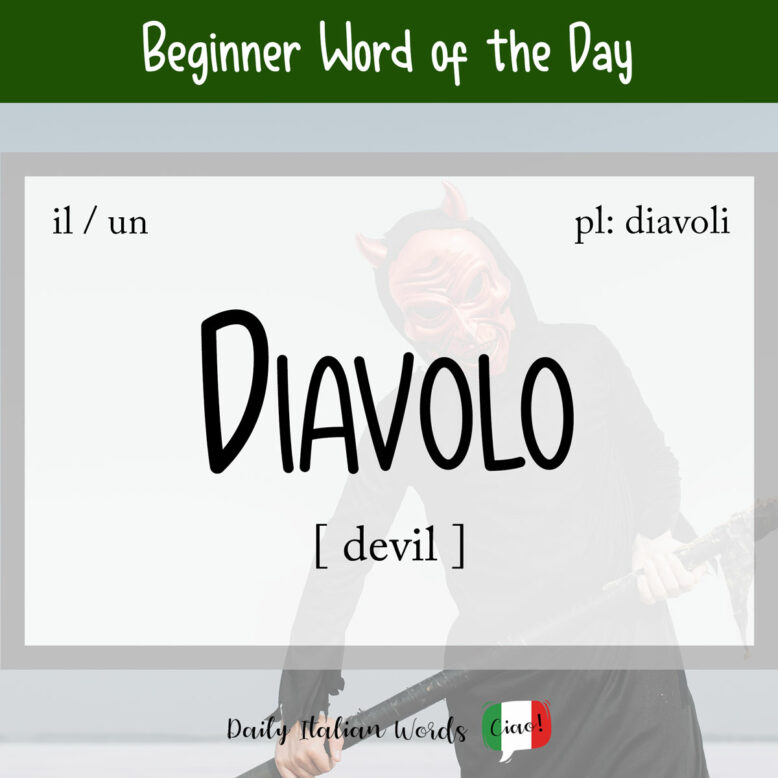In Christian and Jewish belief, the enemy of Dio (God) and the supreme spirit of evil is il Diavolo (the Devil), otherwise known as Satana (Satan).

You will see this word written with both a capital letter ‘D’ and a lower case ‘d’. Generally speaking, the capital letter is used when referring specifically to Satan, while the lower case letter is used when discussing evil spirits, demons or wicked people in general. That said, you will see diavolo written with a lower case ‘d’ on occasions, especially if it appears in an idiom (see below).
Keep in mind that when referring to Satan, it is also necessary to use the masculine definite article il (the). Diavolo is a masculine noun and the plural is diavoli.
- il diavolo = the devil
- un diavolo = a devil
- i diavoli = the devils
- (dei) diavoli = (some) devils
Il Diavolo è il nemico di Dio e degli uomini.
The Devil is the enemy of God and mankind.

Ti vuoi travestire da diavolo per Halloween?
Do you want to dress up as a devil for Halloween?

If you call someone un buon diavolo (a good devil), you are suggesting they are a good/nice fellow. By contrast, un povero diavolo (a poor devil) is a sympathetic expression used towards someone who has been through some kind of hardship.
If you add the diminutive -etto (masculine) to the end, you get the word for “little devil” in Italian. This word is often used to describe mischievous children.

In both English and Italian, you’ll come across the expression l’avvocato del diavolo (the Devil’s advocate), or in other words, a person who expresses a contentious opinion to provoke debate or test the strength of an argument. “To play the devil’s advocate” translates as fare l’avvocato del diavolo.
A rather strong expression you can use to tell angrily someone to stop talking and go away is Vai al diavolo! or simply Al diavolo! both of which are similar to “Go to hell!” Mandare qualcuno al diavolo (lit. to send someone to the Devil) means “to tell someone to go to hell”.
Diavolo is also used for emphasis in questions and exclamations, much like the word “hell/heck” in English.
Dove diavolo sei finito ieri sera? Ero preoccupato!
Where the heck did you go last night? I was worried!
Did you know that…?
Diavolo is also the symbol of the A.C. Milan football team, its players and supporters.
Il Diavolo ha vinto la partita. = A.C. Milan won the game.
Finally we have il Diavolo della Tasmania (the Tasmanian Devil), called as such by European settlers due to its tendency towards “teeth-baring, lunging, and spine-chilling guttural growls“.

Useful idioms featuring ‘diavolo’
Given that the devil is a recurrent symbol in religion and mythology, it is no wonder that it appears in multiple idiomatic expressions.
Abitare a casa del diavolo
Literal translation: to live in the Devil’s house
English meaning: to live in the back of beyond
Avere un diavolo per capello
Literal translation: to have a devil for every single hair on your head
English meaning: to be furious
Avere il diavolo in corpo
Literal translation: to have the Devil in your body
English meaning: to be full of mischief
Fare il diavolo a quattro
Literal translation: to do the Devil in four
English meaning: to raise hell
Parli del diavolo e spuntano le corna
Literal translation: speak of the Devil and the horns appear
English meaning: to speak of the Devil
Saperne una più del diavolo
Literal translation: to know more than the Devil
English meaning: to know more than the Devil
Avere il diavolo addosso
Literal translation: to have the Devil on you
English meaning: to be possessed
Essere come il diavolo e l’acqua santa
Literal translation: to be like the Devil and holy water
English meaning: to be like oil and water
Vendere l’anima al diavolo
Literal translation: to sell the soul to the Devil
English meaning: to sell your soul to the Devil
Heather Broster is a graduate with honours in linguistics from the University of Western Ontario. She is an aspiring polyglot, proficient in English and Italian, as well as Japanese, Welsh, and French to varying degrees of fluency. Originally from Toronto, Heather has resided in various countries, notably Italy for a period of six years. Her primary focus lies in the fields of language acquisition, education, and bilingual instruction.


